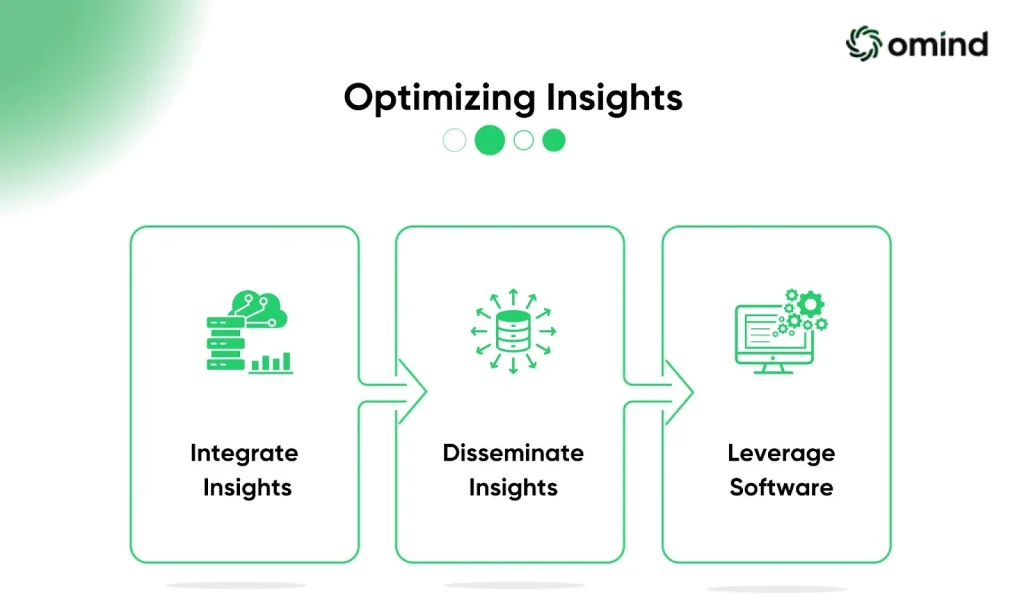Cracking the Customer Code: Unearthing Insights from Data
In today’s data-rich marketing environment, uncovering valuable customer insights is the key to influencing behavior, meeting evolving demands, and shaping the future of your offerings. This article explores the art of extracting marketing insights from data, a crucial skill for marketers seeking a dominant position in the marketplace.
The Power of Marketing Insights
Marketing insights are the hidden gems within a treasure trove of data. Unlike market insights, which offer a broad overview of industry trends and competitor activity, marketing insights provide a laser-sharp focus on your specific target audience. They’re the actionable pieces of information gleaned from data analysis that illuminate the inner workings of your customer’s mind.
- Understanding the “Why” Behind Customer Behavior: By analyzing data points like website clickstream behavior, purchase history, and survey responses, you can uncover the motivations, preferences, and pain points that drive customer decisions. This allows you to tailor your messaging and offerings to resonate directly with their needs and desires.
- Predicting Future Behavior: Marketing insights are not just about understanding the present; they’re a window into the future. By analyzing trends in customer behavior and market sentiment, you can anticipate future needs and preferences. This allows you to develop products and services that are well-positioned to meet evolving customer demands.
- Identifying Untapped Opportunities: Marketing insights can reveal hidden opportunities within your customer base. By analyzing data on customer segments and purchase patterns, you can identify potential new markets or product extensions that cater to previously untapped customer needs. These insights can fuel innovation and help you stay ahead of the curve.
- Quantifying the Impact of Marketing Efforts: Marketing insights take the guesswork out of marketing campaigns. By measuring key metrics like website traffic, conversion rates, and customer engagement, you can assess the effectiveness of your marketing efforts and identify areas for improvement. This allows you to optimize your campaigns for maximum return on investment (ROI).
In essence, marketing insights are the bridge between data and action. They transform raw data points into actionable knowledge that allows you to understand your customers better, predict their needs, and ultimately drive profitable business growth.
The Impact of Marketing Insights

Marketing insights are the driving force behind customer-centric strategies. By understanding your audience’s desires and needs, you can tailor messaging to resonate with them, nudge them towards desired behaviors, and ultimately influence their buying decisions. Additionally, marketing insights unlock a deeper comprehension of customer demand. Identifying pain points and unmet needs allows businesses to innovate and develop products and services that directly address customer preferences. Forward-thinking marketers leverage insights to anticipate future trends and preferences, shaping product roadmaps and ensuring offerings remain relevant in a dynamic marketplace.
Unearthing Gems: Sources and Methods of Data Collection
Extracting marketing insights hinges on acquiring data from a multifaceted approach. Here, we take a look at the technical aspects of various data collection methods:
1. Customer Feedback: Capturing the Voice of the Customer
- Surveys: Employ online survey tools or distribute paper surveys to gather structured feedback. Leverage various question types like multiple-choice, Likert scale, and open-ended questions to capture both quantitative and qualitative data.
- Focus Groups: Conduct moderated group discussions with a representative sample of your target audience. Utilize semi-structured interview techniques to explore customer perceptions, attitudes, and experiences in detail.
- Social Listening: Implement social media listening tools to capture and analyze brand mentions, customer sentiment, and emerging trends across various social media platforms. Utilize natural language processing (NLP) to categorize and extract insights from social media conversations.
2. Digital Analytics: Untangling the Web of User Behavior
- Website Traffic Data: Leverage web analytics platforms like Google Analytics to collect data on website traffic, user demographics, page views, and bounce rates. Utilize session recording tools to visualize user journeys and identify areas of confusion or frustration.
- User Behavior Metrics: Employ web analytics tools to track user behavior metrics like clickstream data, time spent on specific pages, and engagement with interactive elements. Analyze these metrics to understand user intent and identify opportunities for website optimization.
- Customer Journey Mapping Tools: Utilize customer journey mapping software to visualize the complete customer experience across all touchpoints, including website interactions, email marketing campaigns, and social media engagement. Analyze these touchpoints to identify potential friction points and areas for improvement.
3. Optimizing Data Collection for Powerful Insights
The quality of marketing insights is directly correlated to the effectiveness of your data collection methods. Here are some technical considerations:
- Survey Design: Employ robust survey design principles to minimize bias and ensure the validity of your results. Utilize A/B testing to optimize survey length, question wording, and answer choices for maximum engagement and response rates.
- Sampling Techniques: Utilize appropriate sampling techniques, such as random sampling or stratified sampling, to ensure your data represents the entire target population and allows for generalizable insights.
- Data Integration and Management: Implement a robust data integration platform to centralize customer data from various sources. Utilize data cleansing and normalization techniques to ensure data quality and facilitate seamless analysis.
- Advanced Analytics Techniques: Consider employing advanced analytics techniques like machine learning and statistical modeling to uncover hidden patterns and relationships within your data. These techniques can help you identify key customer segments and predict future customer behavior.
Separating Fact from Fallacy: The Importance of Data Interpretation
Data can be a powerful tool, but misinterpreting it can lead to flawed conclusions. Careful analysis is paramount to ensure insights are accurate and actionable. A critical distinction exists between correlation and causation. Just because two data points appear linked doesn’t necessarily mean one causes the other. Always consider alternative explanations and conduct further analysis to establish true causation. Common pitfalls in data analysis include sampling bias, relying on incomplete datasets, and focusing solely on positive outcomes. Employ a robust data analysis framework and seek input from data science experts to mitigate these risks.
Insights in Action: Real-World Examples

Here’s how real-world examples showcase the power of translating insights into tangible strategies:
1. User Experience Optimization: Focus Groups Lead to Design Enhancements
- Challenge: Internal testing fails to uncover a critical usability issue in a new product feature.
- Solution: A focus group reveals confusion and frustration among participants when interacting with the feature.
- Action: Based on insights from the focus group, the product design team can pinpoint the specific pain points and conduct A/B testing of various design iterations. User behavior analytics tools can then track how these design changes impact user engagement and completion rates. This data-driven approach ensures the final product delivers a seamless and intuitive user experience.
2. Targeted Social Media Engagement: Social Listening Fuels Content Strategy
- Challenge: Social media engagement is lagging, and the brand struggles to connect with its target audience.
- Solution: Social media analytics reveal that the target audience is highly active on a specific platform not previously prioritized by the marketing team. Additionally, social listening tools identify trending topics and discussions relevant to the target audience’s interests.
- Action: Leveraging these insights, the marketing team can adjust their social media strategy to focus on the most popular platform. Content creation can then align with the trending topics and discussions identified through social listening. This targeted approach increases reach and engagement with the intended audience.
3. Capitalizing on Market Trends: Data-Driven Advertising Decisions
- Challenge: Traditional advertising campaigns deliver lackluster results, failing to resonate with the evolving preferences of the target audience.
- Solution: Market trend analysis reveals a growing interest in a specific niche within the target market. This niche may not have been previously identified by traditional market research methods.
- Action: Armed with this insight, the marketing team can tailor their advertising campaigns to cater to this niche audience. By focusing messaging and creatives on the specific interests and needs of this segment, the brand can capture a new market share and achieve higher campaign ROI.
4. A/B Testing for Email Optimization: Maximizing Click-Through Rates
- Challenge: Email marketing campaigns experience low click-through rates, hindering lead generation and conversion efforts.
- Solution: A/B testing is conducted on various elements of the email marketing strategy, including subject lines, email formats, and call-to-action buttons. This allows for a data-driven comparison of which elements resonate best with the target audience.
- Action: By analyzing the results of the A/B testing, the marketing team can identify the most effective subject lines, email formats, and call-to-action buttons. Integrating these insights into future email campaigns maximizes click-through rates, leading to increased website traffic, lead generation, and ultimately, conversions.
Optimizing Your Insights

Extracting marketing insights is just the first step. Here’s how to maximize their impact:
- Integrate insights into business decision-making. Share insights with relevant stakeholders across departments to ensure product development, marketing strategies, and customer service practices all align with customer needs.
- Disseminate insights effectively. Create clear, concise reports highlighting key findings and recommendations. Ensure insights are accessible and readily understood by decision-makers.
- Leverage software for enhanced utilization. Marketing automation software can facilitate the integration of customer data and automate personalized marketing efforts based on insights.
Dig Not Just Deeper, But Smarter
This article should give you a comprehensive guide as to how you can uncover insights from the data you gather in the course of a customer journey. By transforming raw data into actionable knowledge, marketers can gain a deeper understanding of their customers and serve them better.
If you’d like a helping hand when it comes to gathering insights from data, or need help with exceptional CX and marketing automation, Omind is your answer. Omind leverages AI to bring to you a conversational platform that helps visitors engage with your business and turns visitors into paying customers. To see how our platform works, schedule a demo today.


